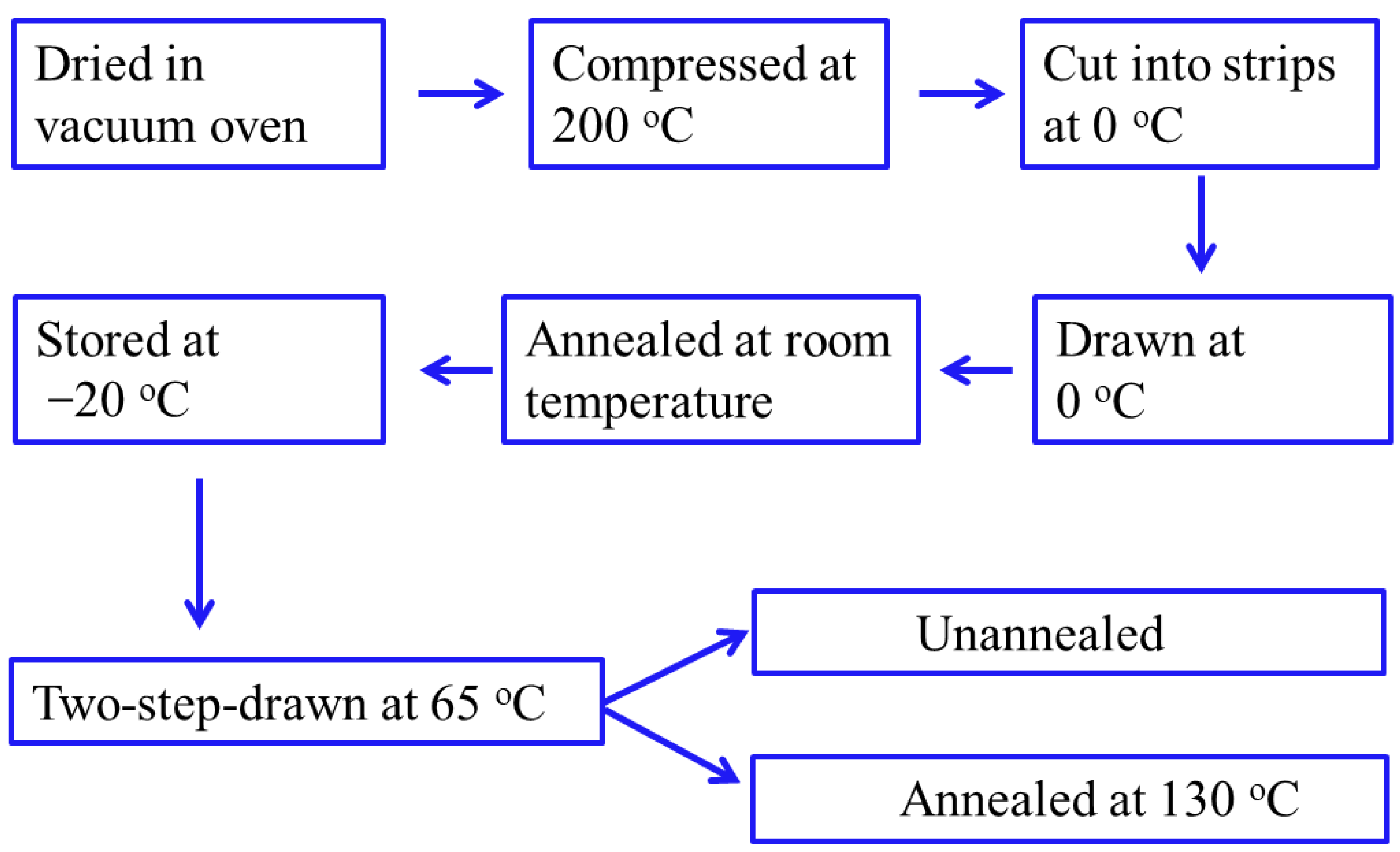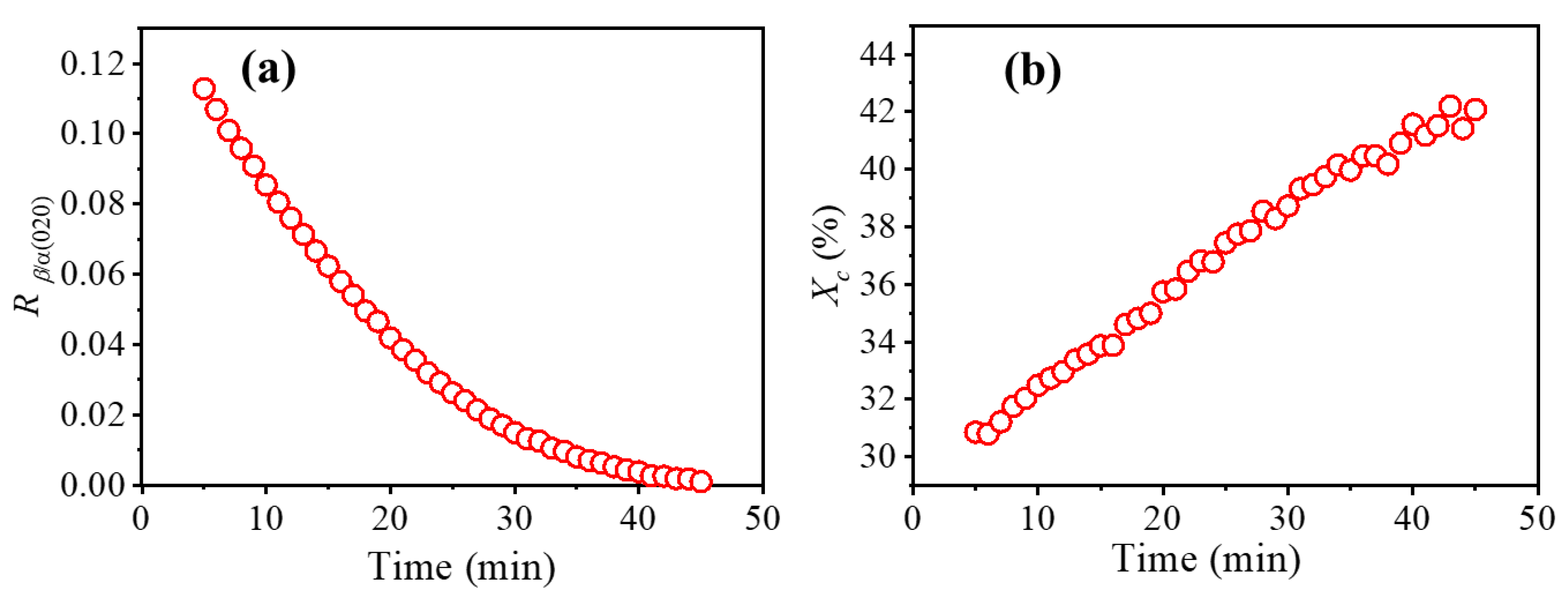The Structural Evolution of β-to-α Phase Transition in the Annealing Process of Poly(3-hydroxybutyrate-co-3-hydroxyvalerate)
Abstract
1. Introduction
2. Materials and Methods
2.1. Materials and Sample Preparation
2.2. Characterization
3. Results and Discussion
3.1. Microstructural Evolution of PHBV Film with β-Form during Annealing
3.2. The Comparison of PHBV Films with β-Form before and after Annealing
3.3. Phase Transition Mechanism of β-Form during Annealing
4. Conclusions
Author Contributions
Funding
Institutional Review Board Statement
Data Availability Statement
Acknowledgments
Conflicts of Interest
References
- Popa, M.S.; Frone, A.N.; Panaitescu, D.M. Polyhydroxybutyrate blends: A solution for biodegradable packaging? Int. J. Biol. Macromol. 2022, 207, 263–277. [Google Scholar] [CrossRef] [PubMed]
- Lenz, R.W.; Marchessault, R.H. Bacterial polyesters: Biosynthesis, biodegradable plastics and biotechnology. Biomacromolecules 2005, 6, 1–8. [Google Scholar] [CrossRef]
- Byrom, D. Polymer synthesis by microorganisms—Technology and economics. Trends Biotechnol. 1987, 5, 246–250. [Google Scholar] [CrossRef]
- Tian, G.; Wu, Q.; Sun, S.Q.; Noda, I.; Chen, G.Q. Two-dimensional Fourier transform infrared spectroscopy study of biosynthesized poly(hydroxybutyrate-co-hydroxyhexanoate) and poly(hydroxybutyrate-co-hydroxyvalerate). J. Polym. Sci. Part B-Polym. Phys. 2002, 40, 649–656. [Google Scholar] [CrossRef]
- Alata, H.; Aoyama, T.; Inoue, Y. Effect of aging on the mechanical properties of poly(3-hydroxybutyrate-co-3-hydroxyhexanoate). Macromolecules 2007, 40, 4546–4551. [Google Scholar] [CrossRef]
- Suttiwijitpukdee, N.; Sato, H.; Unger, M.; Ozaki, Y. Effects of Hydrogen Bond Intermolecular Interactions on the Crystal Spherulite of Poly(3-hydroxybutyrate) and Cellulose Acetate Butyrate Blends: Studied by FT-IR and FT-NIR Imaging Spectroscopy. Macromolecules 2012, 45, 2738–2748. [Google Scholar] [CrossRef]
- Wang, H.; Tashiro, K. Reinvestigation of Crystal Structure and Intermolecular Interactions of Biodegradable Poly(3-Hydroxybutyrate) alpha-Form and the Prediction of Its Mechanical Property. Macromolecules 2016, 49, 581–594. [Google Scholar] [CrossRef]
- Yokouchi, M.; Chatani, Y.; Tadokoro, H.; Teranish, K.; Tani, H. Structural studies of polyesters. 5. molecular and crystal-structures of optically-active and racemic poly(beta-hydroxybutyrate). Polymer 1973, 14, 267–272. [Google Scholar] [CrossRef]
- Sato, H.; Ando, Y.; Mitomo, H.; Ozaki, Y. Infrared Spectroscopy and X-ray Diffraction Studies of Thermal Behavior and Lamella Structures of Poly(3-hydroxybutyrate-co-3-hydroxyvalerate) (P(HB-co-HV)) with PHB-Type Crystal Structure and PHV-Type Crystal Structure. Macromolecules 2011, 44, 2829–2837. [Google Scholar] [CrossRef]
- Sato, H.; Ando, Y.; Dybal, J.; Iwata, T.; Noda, I.; Ozaki, Y. Crystal structures, thermal behaviors, and C-H center dot center dot center dot O=C hydrogen bondings of poly(3-hydroxyvalerate) and poly(3-hydroxybutyrate) studied by infrared spectroscopy and X-ray diffraction. Macromolecules 2008, 41, 4305–4312. [Google Scholar] [CrossRef]
- Iwata, T.; Tsunoda, K.; Aoyagi, Y.; Kusaka, S.; Yonezawa, N.; Doi, Y. Mechanical properties of uniaxially cold-drawn films of poly([R]-3-hydroxybutyrate). Polym. Degrad. Stab. 2003, 79, 217–224. [Google Scholar] [CrossRef]
- Tanaka, F.; Doi, Y.; Iwata, T. The deformation of the chain molecules and crystallites in poly([R]-3-hydroxybutyrate) and poly(4-hydroxybutyrate) under tensile stress. Polym. Degrad. Stab. 2004, 85, 893–901. [Google Scholar] [CrossRef]
- Iwata, T. Strong fibers and films of microbial polyesters. Macromol. Biosci. 2005, 5, 689–701. [Google Scholar] [CrossRef] [PubMed]
- Iwata, T.; Doi, Y. Mechanical properties of uniaxially cold-drawn films of poly (R)-3-hydroxybutyrate and its copolymers. Macromol. Symp. 2005, 224, 11–19. [Google Scholar] [CrossRef]
- Iwata, T.; Fujita, M.; Aoyagi, Y.; Doi, Y.; Fujisawa, T. Time-resolved X-ray diffraction study on poly (R)-3-hydroxybutyrate films during two-step-drawing: Generation mechanism of planar zigzag structure. Biomacromolecules 2005, 6, 1803–1809. [Google Scholar] [CrossRef]
- Kabe, T.; Tsuge, T.; Kasuya, K.; Takemura, A.; Hikima, T.; Takata, M.; Iwata, T. Physical and structural effects of adding ultrahigh-molecular-weight poly (R)-3-hydroxybutyrate to wild-type poly (R)-3-hydroxybutyrate. Macromolecules 2012, 45, 1858–1865. [Google Scholar] [CrossRef]
- Yamane, H.; Terao, K.; Hiki, S.; Kawahara, Y.; Kimura, Y.; Saito, T. Enzymatic degradation of bacterial homo-poly(3-hydroxybutyrate) melt spun fibers. Polymer 2001, 42, 7873–7878. [Google Scholar] [CrossRef]
- Furuhashi, Y.; Imamura, Y.; Jikihara, Y.; Yamane, H. Higher order structures and mechanical properties of bacterial homo poly(3-hydroxybutyrate) fibers prepared by cold-drawing and annealing processes. Polymer 2004, 45, 5703–5712. [Google Scholar] [CrossRef]
- Yang, J.; Zhu, H.J.; Zhao, Y.; Jiang, Q.H.; Chen, H.M.; Liu, G.M.; Chen, P.; Wang, D.J. New insights into the beta-form crystal toughening mechanism in pre-oriented PHBV films. Eur. Polym. J. 2017, 91, 81–91. [Google Scholar] [CrossRef]
- Cornibert, J.; Marchessault, R.H. Physical properties of poly-beta-hydroxybutyrate.4. conformational-analysis and crystalline-structure. J. Mol. Biol. 1972, 71, 735–756. [Google Scholar]
- Orts, W.J.; Marchessault, R.H.; Bluhm, T.L.; Hamer, G.K. Observation of strain-induced beta-form in poly(beta-hydroxyalkanoates). Macromolecules 1990, 23, 5368–5370. [Google Scholar] [CrossRef]
- Perret, E.; Hufenus, R. Insights into strain-induced solid mesophases in melt-spun polymer fibers. Polymer 2021, 229, 107466. [Google Scholar] [CrossRef]
- Perret, E.; Reifler, F.A.; Gooneie, A.; Hufenus, R. Tensile study of melt-spun poly(3-hydroxybutyrate) P3HB fibers: Reversible transformation of a highly oriented phase. Polymer 2019, 180, 104376. [Google Scholar] [CrossRef]
- Phongtamrug, S.; Tashiro, K. X-ray crystal structure analysis of poly(3-hydroxybutyrate) beta-form and the proposition of a mechanism of the stress-induced alpha-to-beta phase transition. Macromolecules 2019, 52, 2995–3009. [Google Scholar] [CrossRef]
- Gong, L.; Chase, D.B.; Noda, I.; Liu, J.L.; Martin, D.C.; Ni, C.Y.; Rabolt, J.F. Discovery of beta-form crystal structure in electrospun poly (R)-3-hydroxybutyrate-co-(R)-3-hydroxyhexanoate (PHBHx) nanofibers: From fiber mats to single fibers. Macromolecules 2015, 48, 6197–6205. [Google Scholar] [CrossRef]
- Nishiyama, Y.; Tanaka, T.; Yamazaki, T.; Iwata, T. 2D NMR observation of strain-induced beta-form in poly (R)-3-hydroxybutyrate. Macromolecules 2006, 39, 4086–4092. [Google Scholar] [CrossRef]
- Tanaka, T.; Fujita, M.; Takeuchi, A.; Suzuki, Y.; Uesugi, K.; Ito, K.; Fujisawa, T.; Doi, Y.; Iwata, T. Formation of highly ordered structure in poly (R)-3-hydroxybutyrate-co-(R)-3-hydroxyvalerate high-strength fibers. Macromolecules 2006, 39, 2940–2946. [Google Scholar] [CrossRef]
- Perret, E.; Sharma, K.; Tritsch, S.; Hufenus, R. Reversible mesophase in stress-annealed poly(3-hydroxybutyrate) fibers: A synchrotron x-ray and polarized ATR-FTIR study. Polymer 2021, 231, 124141. [Google Scholar] [CrossRef]
- Xia, Z.J.; Zhao, H.Y.; Li, Y.H.; Ma, Y.M.; Tian, F.C.; Chen, W. Stress-induced crystallization of the metastable beta-Form of poly((R)-3-hydroxybutyrate-co-4-hydroxybutyrate). ACS Appl. Polym. Mater. 2021, 3, 4109–4117. [Google Scholar] [CrossRef]
- Murakami, R.; Sato, H.; Dybal, J.; Iwata, T.; Ozaki, Y. Formation and stability of beta-structure in biodegradable ultra-high-molecular-weight poly(3-hydroxybutyrate) by infrared, Raman, and quantum chemical calculation studies. Polymer 2007, 48, 2672–2680. [Google Scholar] [CrossRef]
- Kabe, T.; Tanaka, T.; Marubayashi, H.; Hikima, T.; Takata, M.; Iwata, T. Investigating thermal properties of and melting-induced structural changes in cold-drawn P(3HB) films with α- and β-structures using real-time X-ray measurements and high-speed DSC. Polymer 2016, 93, 181–188. [Google Scholar] [CrossRef]
- Yamane, H.; Terao, K.; Hiki, S.; Kimura, Y. Mechanical properties and higher order structure of bacterial homo poly(3-hydroxybutyrate) melt spun fibers. Polymer 2001, 42, 3241–3248. [Google Scholar] [CrossRef]
- Dai, X.Y.; Xing, Z.L.; Yang, W.; Zhang, C.; Li, F.; Chen, X.; Li, C.; Zhou, J.J.; Li, L. The Effect of Annealing on the Structure and Electric Performance of Polypropylene Films. Int. J. Polym. Sci. 2022, 2022, 5970484. [Google Scholar] [CrossRef]
- Bai, H.W.; Wang, Y.; Zhang, Z.J.; Han, L.; Li, Y.L.; Liu, L.; Zhou, Z.W.; Men, Y.F. Influence of Annealing on Microstructure and Mechanical Properties of Isotactic Polypropylene with beta-Phase Nucleating Agent. Macromolecules 2009, 42, 6647–6655. [Google Scholar] [CrossRef]
- Bai, H.W.; Luo, F.; Zhou, T.N.; Deng, H.; Wang, K.; Fu, Q. New insight on the annealing induced microstructural changes and their roles in the toughening of beta-form polypropylene. Polymer 2011, 52, 2351–2360. [Google Scholar] [CrossRef]
- Kang, H.L.; Wang, Z.; Lin, N.; Hao, X.M.; Liu, R.G. Influence of drawing and annealing on the structure and properties of bio-based polyamide 56 fibers. J. Appl. Polym. Sci. 2022, 139, e53221. [Google Scholar] [CrossRef]
- Yang, J.; Chen, R.Y.; Yang, C.; Liu, H.Y.; Zhao, J.X.; Chen, Y.; Wen, T.; Zhao, Y. The formation and transformation of β-form crystals in poly(3-hydroxybutyrate-co-3-hydroxy valerate. Polym. Bull. 2023, 36, 83–92. [Google Scholar]
- Chen, H.M.; Shen, Y.; Yang, J.H.; Huang, T.; Zhang, N.; Wang, Y.; Zhou, Z.W. Molecular ordering and alpha′-form formation of poly(L-lactide) during the hydrolytic degradation. Polymer 2013, 54, 6644–6653. [Google Scholar] [CrossRef]
- Sanchez, I.C.; Peterlin, A.; Eby, R.K.; McCracki, F.L. Theory of polymer crystal thickening during annealing. J. Appl. Phys. 1974, 45, 4216–4219. [Google Scholar] [CrossRef]
- Chen, J.W.; Dai, J.; Yang, J.H.; Zhang, N.; Huang, T.; Wang, Y.; Zhang, C.L. Annealing induced microstructure and mechanical property changes of impact resistant polypropylene copolymer. Chin. J. Polym. Sci. 2015, 33, 1211–1224. [Google Scholar] [CrossRef]
- Park, J.W.; Doi, Y.; Iwata, T. Uniaxial drawing and mechanical properties of poly (R)-3-hydroxybutwrate /poly(L-lactic acid) blends. Biomacromolecules 2004, 5, 1557–1566. [Google Scholar] [CrossRef] [PubMed]
- Scherrer, P. Nachrichten von der Gesellschaft der Wissenschaften zu Göttingen, Mathematisch-Physikalische Klasse. GoTt. Nachr. 1918, 2, 98–100. [Google Scholar]
- Peterlin, A. Plastic-deformation of polymers with fibrous structure. Colloid Polym. Sci. 1975, 253, 809–823. [Google Scholar] [CrossRef]
- Murthy, N.S.; Bednarczyk, C.; Moore, R.A.F.; Grubb, D.T. Analysis of small-angle X-ray scattering from fibers: Structural changes in nylon 6 upon drawing and annealing. J. Polym. Sci. Part B-Polym. Phys. 1996, 34, 821–835. [Google Scholar] [CrossRef]
- Tang, Y.; Jiang, Z.; Men, Y.; An, L.; Enderle, H.-F.; Lilge, D.; Roth, S.V.; Gehrke, R.; Rieger, J. Uniaxial deformation of overstretched polyethylene: In-situ synchrotron small angle X-ray scattering study. Polymer 2007, 48, 5125–5132. [Google Scholar] [CrossRef]
- Tanaka, T.; Yabe, T.; Teramachi, S.; Iwata, T. Mechanical properties and enzymatic degradation of poly (R)-3-hydroxybutyrate fibers stretched after isothermal crystallization near T-g. Polym. Degrad. Stab. 2007, 92, 1016–1024. [Google Scholar] [CrossRef]
- Perret, E.; Reifler, F.A.; Gooneie, A.; Chen, K.; Selli, F.; Hufenus, R. Structural response of melt-spun poly(3-hydroxybutyrate) fibers to stress and temperature. Polymer 2020, 197, 122503. [Google Scholar] [CrossRef]












| Lattice | Space Group | a (Å) | b (Å) | c (Å) | Molecular Conformation | Reference | |
|---|---|---|---|---|---|---|---|
| α-form | Orthorhombic | P212121-D24 | 5.67 | 13.15 | 5.91 | 21 helix | Wang et al. [7] |
| β-form | Hexagonal | P3221 | 9.22 | 9.22 | 4.66 | All-trans zigzag | Phongtamrug et al. [24] |
Disclaimer/Publisher’s Note: The statements, opinions and data contained in all publications are solely those of the individual author(s) and contributor(s) and not of MDPI and/or the editor(s). MDPI and/or the editor(s) disclaim responsibility for any injury to people or property resulting from any ideas, methods, instructions or products referred to in the content. |
© 2023 by the authors. Licensee MDPI, Basel, Switzerland. This article is an open access article distributed under the terms and conditions of the Creative Commons Attribution (CC BY) license (https://creativecommons.org/licenses/by/4.0/).
Share and Cite
Yang, J.; Liu, X.; Zhao, J.; Pu, X.; Shen, Z.; Xu, W.; Liu, Y. The Structural Evolution of β-to-α Phase Transition in the Annealing Process of Poly(3-hydroxybutyrate-co-3-hydroxyvalerate). Polymers 2023, 15, 1921. https://doi.org/10.3390/polym15081921
Yang J, Liu X, Zhao J, Pu X, Shen Z, Xu W, Liu Y. The Structural Evolution of β-to-α Phase Transition in the Annealing Process of Poly(3-hydroxybutyrate-co-3-hydroxyvalerate). Polymers. 2023; 15(8):1921. https://doi.org/10.3390/polym15081921
Chicago/Turabian StyleYang, Jian, Xianggui Liu, Jinxing Zhao, Xuelian Pu, Zetong Shen, Weiyi Xu, and Yuejun Liu. 2023. "The Structural Evolution of β-to-α Phase Transition in the Annealing Process of Poly(3-hydroxybutyrate-co-3-hydroxyvalerate)" Polymers 15, no. 8: 1921. https://doi.org/10.3390/polym15081921
APA StyleYang, J., Liu, X., Zhao, J., Pu, X., Shen, Z., Xu, W., & Liu, Y. (2023). The Structural Evolution of β-to-α Phase Transition in the Annealing Process of Poly(3-hydroxybutyrate-co-3-hydroxyvalerate). Polymers, 15(8), 1921. https://doi.org/10.3390/polym15081921










